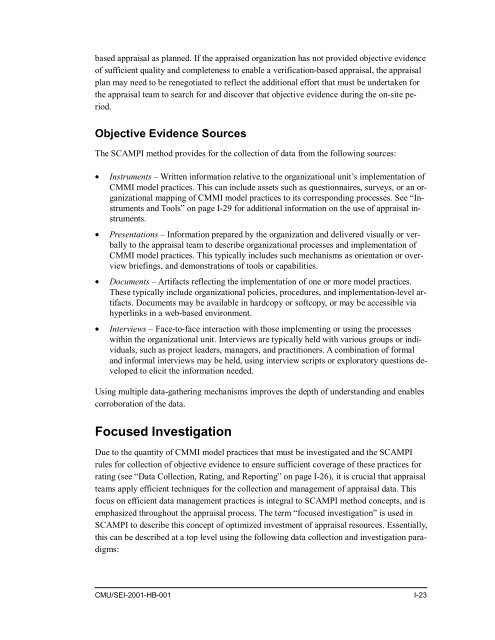Standard CMMI Appraisal Method for Process Improvement (SCAMPI)
Standard CMMI Appraisal Method for Process Improvement (SCAMPI)
Standard CMMI Appraisal Method for Process Improvement (SCAMPI)
Create successful ePaper yourself
Turn your PDF publications into a flip-book with our unique Google optimized e-Paper software.
ased appraisal as planned. If the appraised organization has not provided objective evidence<br />
of sufficient quality and completeness to enable a verification-based appraisal, the appraisal<br />
plan may need to be renegotiated to reflect the additional ef<strong>for</strong>t that must be undertaken <strong>for</strong><br />
the appraisal team to search <strong>for</strong> and discover that objective evidence during the on-site period.<br />
Objective Evidence Sources<br />
The <strong>SCAMPI</strong> method provides <strong>for</strong> the collection of data from the following sources:<br />
• Instruments – Written in<strong>for</strong>mation relative to the organizational unit’s implementation of<br />
<strong>CMMI</strong> model practices. This can include assets such as questionnaires, surveys, or an organizational<br />
mapping of <strong>CMMI</strong> model practices to its corresponding processes. See “Instruments<br />
and Tools” on page I-29 <strong>for</strong> additional in<strong>for</strong>mation on the use of appraisal instruments.<br />
• Presentations – In<strong>for</strong>mation prepared by the organization and delivered visually or verbally<br />
to the appraisal team to describe organizational processes and implementation of<br />
<strong>CMMI</strong> model practices. This typically includes such mechanisms as orientation or overview<br />
briefings, and demonstrations of tools or capabilities.<br />
• Documents – Artifacts reflecting the implementation of one or more model practices.<br />
These typically include organizational policies, procedures, and implementation-level artifacts.<br />
Documents may be available in hardcopy or softcopy, or may be accessible via<br />
hyperlinks in a web-based environment.<br />
• Interviews – Face-to-face interaction with those implementing or using the processes<br />
within the organizational unit. Interviews are typically held with various groups or individuals,<br />
such as project leaders, managers, and practitioners. A combination of <strong>for</strong>mal<br />
and in<strong>for</strong>mal interviews may be held, using interview scripts or exploratory questions developed<br />
to elicit the in<strong>for</strong>mation needed.<br />
Using multiple data-gathering mechanisms improves the depth of understanding and enables<br />
corroboration of the data.<br />
Focused Investigation<br />
Due to the quantity of <strong>CMMI</strong> model practices that must be investigated and the <strong>SCAMPI</strong><br />
rules <strong>for</strong> collection of objective evidence to ensure sufficient coverage of these practices <strong>for</strong><br />
rating (see “Data Collection, Rating, and Reporting” on page I-26), it is crucial that appraisal<br />
teams apply efficient techniques <strong>for</strong> the collection and management of appraisal data. This<br />
focus on efficient data management practices is integral to <strong>SCAMPI</strong> method concepts, and is<br />
emphasized throughout the appraisal process. The term “focused investigation” is used in<br />
<strong>SCAMPI</strong> to describe this concept of optimized investment of appraisal resources. Essentially,<br />
this can be described at a top level using the following data collection and investigation paradigms:<br />
CMU/SEI-2001-HB-001 I-23
















